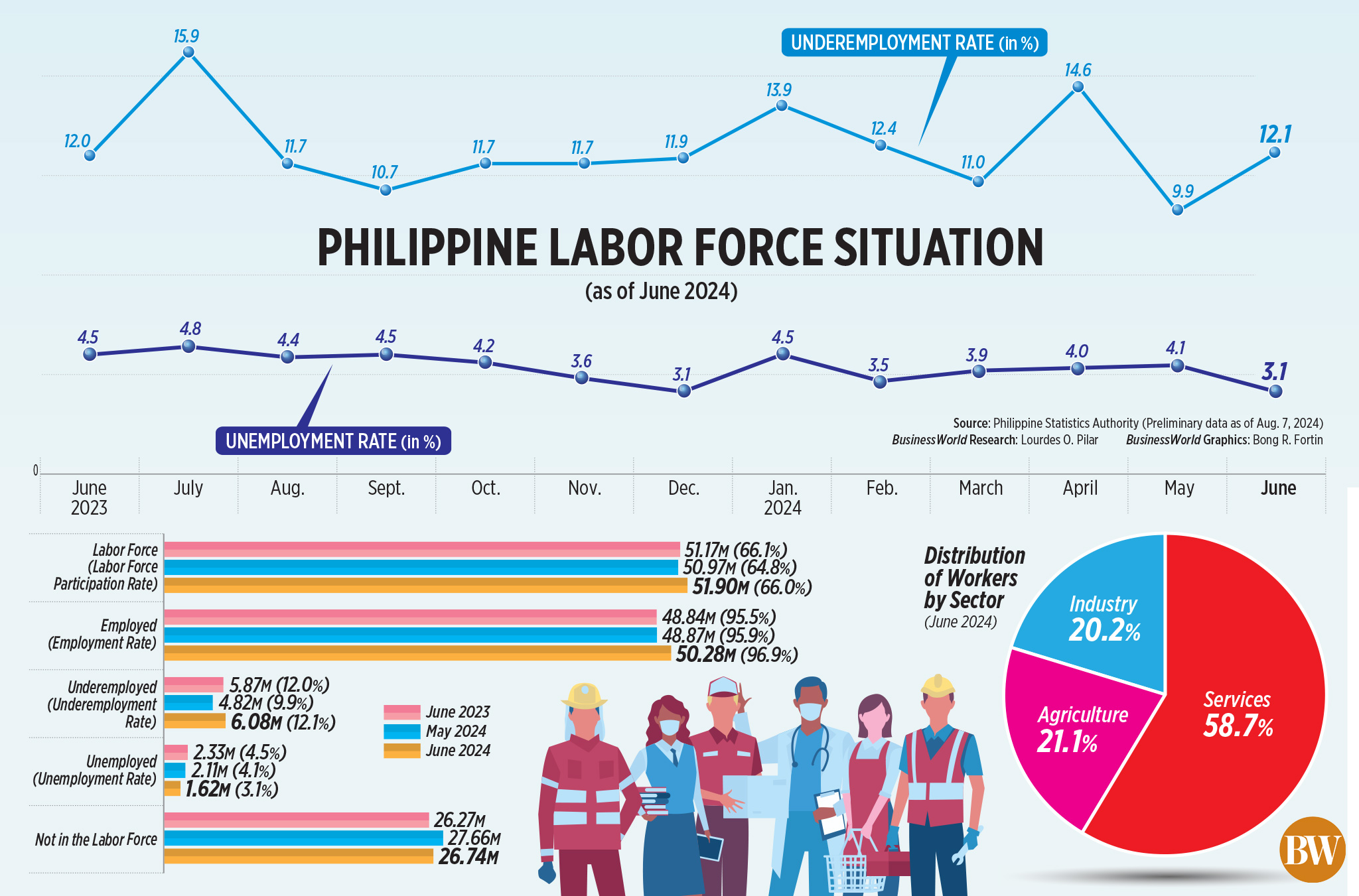THE UNEMPLOYMENT RATE in June fell to 3.1%, the lowest in two decades, as hiring in the construction sector surged, the Philippine Statistics Authority (PSA) reported on Wednesday.
Preliminary data from the Philippine Statistics Authority (PSA) showed the jobless rate slipped from 4.1% in May and 4.5% in June 2023.
The June unemployment rate was the same as in December 2023. It was also the lowest jobless rate since April 2005, when the statistics agency revised its definition of unemployed to Filipinos aged 15 years and older without a job, available for work, and actively seeking one.
This translated to 1.62 million unemployed Filipinos in June, down by 486,000 from 2.11 million in May.
Year on year, unemployment went down by 707,000 from 2.33 million in June 2023.
This was also the lowest number of unemployed Filipinos since the 1.6 million recorded in December last year.
In the first half, the unemployment rate averaged 3.9%, lower than the 4.6% average a year ago.
“We can see the economic activity linked to construction activities substantially increased… (In construction) we added 938,000 jobs (year on year),” PSA Undersecretary and National Statistician Claire Dennis S. Mapa said in mixed English and Filipino during the press briefing on Wednesday.
However, underemployment — those who want longer hours or an additional job — went up to 12.1% in June from 9.9% in May. This was a tad higher than 12% in June 2023.
The ranks of the underemployed Filipinos reached 6.08 million, up by 1.27 million month on month and 208,000 year on year.
As of end-June, the average underemployment rate stood at 12.3%, lower than 12.5% last year.
“Year on year, the labor force participation rate increased substantially… What happens is that the labor market cannot absorb this, so not everyone can get full-time jobs… This is why there is an increase in underemployed people,” Mr. Mapa said.
Security Bank Corp. Chief Economist Robert Dan J. Roces said in a Viber message the higher underemployment rate could have been due to the sectoral slowdowns and lack of available part-time work.
In June, the employment rate rose to 96.9%, equivalent to 50.28 million Filipinos. This was slightly higher than 95.9% (equivalent to 48.87 million) in May, and 95.5% (48.84 million) in June 2023.
In the first half, the employment rate averaged 96.1%, up from 95.4% a year ago.
The service sector remained the top employer, accounting for 58.7% of jobs in June, followed by agriculture (21.1%) and industry (20.2%).
In June, month-on-month job gains were recorded in construction (up 680,000 to 5.77 million), agriculture and forestry (up 571,000 to 9.53 million), and wholesale and retail trade (490,000 to 10.6 million).
“The government’s swift implementation of infrastructure projects and the continued improvement of operating conditions for manufacturing firms have led to these employment gains. Increasing investments in renewable energy, water supply, and mining and quarrying have also supported employment growth in these areas,” National Economic and Development Authority Secretary Arsenio M. Balisacan said in a statement.
On the other hand, the biggest monthly job loss was seen in public administration and defense, which cut 466,000 jobs to 2.67 million. Job losses were also seen in education (down 184,000 to 1.51 million), and transportation and storage (down 152,000 to 3.57 million).
Meanwhile, construction saw the largest annual increase in jobs, adding 938,000 jobs to 5.77 million. Significant job gains were also seen in wholesale and retail trade (up 527,000 to 10.6 million), and accommodation and food service activities (up 396,000 to 2.62 million).
Year on year, agriculture and forestry cut 916,000 jobs to 9.53 million. Annual job losses were also seen in public administration and defense (down 340,000 to 2.67 million) and fishing and aquaculture (down 81,000 to 1.09 million).
Sentro ng mga Nagkakaisa at Progresibong Manggagawa Secretary-General Josua T. Mata questioned what he called the “flawed employment strategy” of the government.
“Worker underutilization remains high. The combined underemployment and unemployment rate rose from 14% in May 2024 to 15.2% in June 2024. This means nearly one in six workers are either unemployed or underemployed and unable to fully contribute to the economy,” he said in a Viber message.
The country’s labor force reached 51.9 million in June, increasing by 926,000 from 50.97 million in May.
On an annual basis, the labor force increased by 730,000 from 51.17 million.
This translated to a labor force participation rate of 66%, higher than the 64.8% in the previous month, but lower than 66.1% last year.
The average Filipino employee worked for 40.9 hours a week, up from 40.6 hours in May and from the 40 hours in June 2023. — Charles Worren E. Laureta

